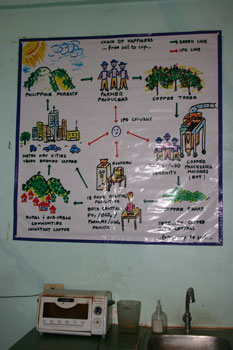In today’s ultra-green, eco-guilt complex social environment, many people wax lyrical that there is no such thing as true eco- friendly travel. Fuel prices are fluctuating madly, CO2 levels are rising along with oceans and natural disasters due to climate change wreak havoc across the globe. It is no wonder that flying, which in itself consumes a huge amount of fuel and energy, draws much criticism. All this on-the-level-of-Mum guilt might compel you to give up your travel plans altogether and stay at home.
You may alleviate your guilt somewhat by buying second-hand travel goods or carbon credits, but are you fooling yourself by thinking that you’re somehow saving the Amazon rain forest or improving ecological sustainability in a small African village? The majority of us travel in a way that means we are in and out of a country within a short period of time, leaving behind an increasingly large ecological footprint and little else.
That being said, there are ways to make as much of a contribution as you can to the places you visit and reduce your energy consumption on the road, whilst being fully aware that ‘Green Ego’ is a truly dangerous thing.
Before you leave

If you are willing to travel with the bare minimum, leave any electronics at home. Most of us, however, find it necessary to bring our computers, cameras and iPods with us. Simple things you can do to reduce your electricity usage in the places you visit include using solar powered devices, hand crank electronics (such as the new media player that requires only your ability to crank it and crank it good), cameras that use NiMH rechargeable batteries and uncomplicated notebooks such as Asus’ Eee PC that requires very little energy. There are a multitude of companies that sell such products and have company wide sustainable, renewable practices.
Bring biodegradeable and organic soaps on the road with you to care for both your well being and the planet’s. Dr Bronner’s is an excellent all-round liquid soap that you can use from head to toe and to wash your clothes. Speaking of clothes, go second-hand and support companies that sustainably produce earth-friendly fibres such as organic bamboo or hemp. Not only do they look, feel and smell great, they travel well too – drying quicker than cotton.
On the road – Getting from A to B in a green way

Flying is a great way to release Earth warming gases directly into the atmosphere, with nitrous oxide and vapours doing additional harm to CO2 at high altitudes. So take the bus or train instead (or if you’re so inclined, bike around the world!). If you must fly, choose an airline that supports green travel and makes conscious efforts to reduce their impact on the environment.
Carbon offsets may or may not be a passing fad, but if you do your research, you will find many reputable and reliable companies that focus on renewable/clean energy, emissions-reducing initiatives, credits in existing clean energy and sustainable development projects.
Some well known groups include the strict CarbonNeutral Company, non-profit CarbonFund and Native Energy which aids communities in need. Check out www.enviro.aero for more information on the impact of the airline industry on the environment, and Sustainable Travel International to offset your flights.
Remember that carbon offsets are not a substitute for changing your travel habits, but simply a way to compensate for emissions you are unable to eradicate in other ways. Simple things you can do is avoid short to medium haul flights, fly direct (as 25% of your flights emissions are pumped into the atmosphere at take off) and fly during the day, on newer, more fuel efficient aircraft.
One of the most effective and energy conserving travel practices you can adopt is taking public transport. Taking the bus, in countries where it is safe to do so, generates about a quarter of the carbon you would emit if you travel by plane. Bicycle and motorbike tours are available through much of the world and allow you flexibility and are relatively guilt free – many European countries have bicycles for rent throughout their cities or even free bicycles.
Train travel has become increasingly popular in recent years, as it is generally cheap, comfortable, allows you to admire more of a country’s scenery and cuts your emissions dramatically – think of the amazing Trans-Siberian Express which traipses across some of the world’s most stunning countryside. Some train loving addicts share their tips on seat61.com and traintraveling.com.
Where to stay to be green

For those who like the high life, there is no shortage of accommodation that purports to be “green” – the Intercontinental chain of hotels, which includes Holiday Inn, instituted energy conservation practices way back in 1990. Remember when you’re perusing your next fancy hotel that nearly 5 tons of waste and approximately 80,000 gallons of water are created every year by each hotel room – multiply that by the sheer number of hotels across the globe, and you can see that solutions are required, and pronto.
Do your research carefully and make sure that your hotel has a reliable recycling program, compost their food scraps, clean their waste water safely and contribute to their local communities by promoting renewable practices. Email your friendly hotel manager and suggest that they use eco-friendly cleaning products, recycled, unbleached toilet paper, energy-saving compact fluorescent light bulbs and turn off lights and air-conditioning in unoccupied rooms.
As for what you can do when occupying their premises, start with requesting sheets and towel changes only every three days, effectively reducing your laundry related emissions by nearly 70%.
If you are prepared to rough it out and make a change at the same time, volunteering at eco-communities, eco-villages or organic farms may be the way to go. Wwoof.org which offers “Wwoofing” (volunteering at organic farms in exchange for room and boarding) has been popular amongst hippies and students alike, but is truly a way to contribute to the communities that you visit, not to mention you learn about planting, harvesting, sustainable practices and appropriate technologies.
Eco-villages are beautiful examples of community life that include self sufficiency in food, off grid electricity and water as well as holistic solutions and education regarding the future of our planet- find one to visit at the Global Ecovillage Network and discover places that you would usually miss if you have your nose in your country specific Lonely Planet guide.
What to do on a green holiday

Ecotourism is the new hot word in travel, along with “green”, “sustainable” and “reducing carbon emissions.” However, as is usually the case, scrupulous business minded individuals often stick the word “eco” onto their trips without actually instituting sustainable practices.
Once again, it is our responsibility as travelers to do our research on each company we may be interested in giving our money to in exchange for a “real eco-trek” to ensure that we are supporting the right cause. Be aware that the recent boom in visits to disappearing attractions (e.g. glaciers, polar bears and rain forests) may instead greatly harm communities, plants, animals and habitats which are not equipped to protect themselves from the treading of hiking boot covered tourist feet.
Support the local economy of the places you visit but perusing their bazaars and markets, being careful to ask if that fancy beaded headdress was made by a Karen tribe member of Thailand or in a super Handicrafts of the World factory in Taiwan or Macau – who can ignore the generic tie dye print pants and Indian style cotton shirts rampant through Thailand, Vietnam, Cambodia and India?
Visit places that sell fair-trade products and clearly show their commitment to local industries. As the demand for cheap, disposable and tacky souvenirs disappears, local economies are sure to thrive as sustainable livelihoods flourish – not to mention the carbon emissions you prevent from being created by transporting items from other countries.
Getting back to nature is essential, both for the globe and for your soul. Watching a sunrise or a sunset with a loved one, climbing volcanoes (try swimming in Mt. Pinatubo’s aquamarine-watered crater in the Philippines, for example), exploring forests, going on self directed hikes or dives are life enriching and sustainable travel treats that cause minimal damage to the Earth.
Do it yourself is the key! Not only will you leave with a much greater appreciation of where you fit in this living organism we call Earth, you will also be a shining example to others of how simple travel can be the most fulfilling.
What to eat to be green

Refusing meat is the single most effective action you can take to cut your carbon footprint whilst traveling, while also reducing your chances of getting Delhi Belly. The UN released a report in 2006 (“Livestock’s Long Shadow”), based on energetic research, supporting this fact. Knowing that livestock contributes 18% of all greenhouse gases to our atmosphere, both directly and indirectly, this makes a lot of sense.
Going local is also an essential, as it supports surrounding communities and encourages them to continue trading and circulating their finances locally. One example is 18 Days Coffee Cooperative in the Philippines which supports Filipino coffee farmers, offers fair prices and installs roasting machines which allow for a self sufficient coffee industry within their local Barangays (arengga.com). Across the globe, such groups exist, with a focus on sustainability rather than large profits, giving power to local people and farmers.
Green is easy
Armed with all this information, you are now ready to take on the world in your Tevas, but aware of your impact on the planet when you travel. We are all responsible for the future of this planet, and travel allows us to appreciate the importance of this. Empower yourself and onward ho! See you on the road (hopefully on a bike).